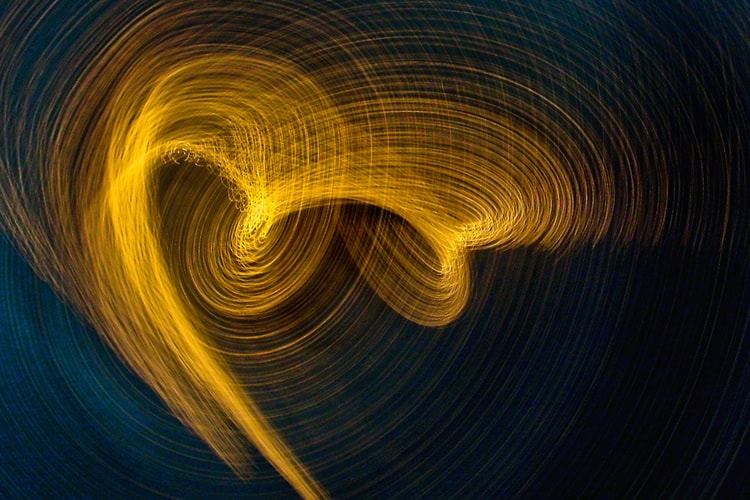Fun With Kinetic Photography!
Kinetic photography, also sometimes called camera-toss photography for soon-to-be-obvious reasons, is not for everyone. Let’s get that straight right off the bat! But for those open-minded photographers who are always up for a bit of experimentation and trial and error, kinetic photography will be right up their alley.
This experimental photography method is defined by the photographer utilizing movement that comes from physics to create a picture. In most cases, you will not hold the camera directly, but let your camera respond to forces applied to it to create your images. Has your interested been piqued yet? Good!

photo by Thomas Quine
Kinetic photography can include everything from shaking your camera’s wrist strap while shooting and letting the camera fall off of objects while taking a shot to actually tossing the camera in the air while shooting and vigorously moving your camera as you snap pictures.
Naturally, such experimental photography has provoked intense discussions among some photographers about just what is “real” photography and what isn’t. We’re not going to get into that in this post, though. All we want to accomplish is to introduce you to all the unorthodox fun you can have with camera-toss photography.
Conservative Kinetic Photography Explained
This is not conservative in the political sense, but conservative as in the “safe” way of going about this highly unique experiment with photography. To be totally honest, camera tossing is never completely safe (especially for your camera), but this approach is more likely to preserve your equipment and sanity than the more extreme alternative discussed in the next section.
First things first: Ensure that the strap of your camera is secure. Now, adjust your camera settings to ensure that the exposure is sufficiently long enough to keep your shutter open for the entire length of the swing. In addition, everything else ought to restrict any incoming light to the point where there is no overblown picture that suffers from little or no detail.
Here is where the real fun starts: Just hold the camera strap firmly and click your shutter button. You can then swing, shake, toss or twirl (or use a combination of these actions) your whole camera to obtain some absolutely crazy and diverse outcomes. The best part of this experimental approach is the total freedom you attain: There is nothing wrong that you can do. Want to create some zig zags? Go for it. Hankering for arcs of light instead? Go for it!
If you don’t have the guts to mess around with your camera in this risky way, you can cheat by putting the camera on a tripod and either shaking or spinning your subject (make sure your subject is not a person, of course!). A simple example could involve something as basic as shaking a bunch of Christmas lights during a long exposure.
On the Other Hand…There’s Always Extreme Kinetic Photography
Okay, here is what you’ve been waiting for… extreme kinetic photography! Sure, the above already sounded a little too extreme for the comfort zone of many a photographer, but, believe it or not, you can still go a step further into all-out adventurism with camera-toss photography.
Some of the more—let’s call them—enthusiastic members of the kinetic-photography community believe that camera tossing must involve a strapless camera… that actually becomes airborne. Hence, this would be true camera tossing for the real purist. Of course, to successfully pull off this approach to kinetic photography, you have to excel at hand-eye coordination, be experienced at easily catching flying objects and have a good amount of guts!
Keep in mind that you want to generate effective motion instead of throwing the camera as high as you want to try. Concentrate on tossing your camera in various directions to obtain results that you wouldn’t come close to obtaining by just holding onto the camera strap and spinning it around.
Super Advice to Help You Get the Best Results

photo by Robert Couse-Baker
-
The Right Lighting Conditions
It’s advised that you use a somewhat dark room. You can even experiment with different sources of light to determine what does the trick best. It’s always better to begin with just one light source and then eventually use more to incorporate further complexity into your shots. Of course, remember to keep checking and changing around your setup to achieve desired results.
-
An Inexpensive Camera
It goes without saying that, just to be on the really safe side, you’ll want to use an inexpensive camera, especially when you are just getting the hang of it. So set aside that pricey DSLR and pick up an older camera that you perhaps haven’t used in a while. If you’re concerned about getting inferior images due to the use of a cheaper camera, don’t be: Kinetic-photography effects are so easy to produce that even inexpensive cameras can garner attractive shots!
-
Prepare a Soft Landing Spot
You’ll want to keep using your camera for this technique, even if it’s an older one, so the best way to preserve it is to make sure that it has a soft spot in which to land. Attempt standing over either your bed or couch on your first try. Note that even a softer landing could still shake up the finer and more sensitive insides of the camera, yet it’s obviously still a far preferable option to having your camera land on the hard ground!
-
Exercise Patience
They say that patience is a virtue. Who are these people who have come up with that proverb? Is it ancient sages? No, just members of the kinetic-photography community! Don’t think that coming up with stunning images is as easy as trying this a few times. Get ready for a lot of invested time and experimentation to figure out which techniques work the best with your particular camera and environment.
Not for Everybody, to Be Sure!
Kinetic photography just isn’t for everyone. It doesn’t take a bunch of Captains Obvious to figure this out. Besides worrying about whether or not your equipment will survive, you may be wondering if this is really what “real” photographers spend their time on in the first place! If you like experimentation, though, adventurism and having fun with your photography, then throw yourself into kinetic photography, nonetheless. It’s that simple.
Now it’s your turn. Tell us all about your thoughts on camera tossing via Twitter or Facebook section below. Have you ever tried kinetic photography before? Do you ever want to? What do you think of the folks who are into this technique? Are they just loco? Sound off!
